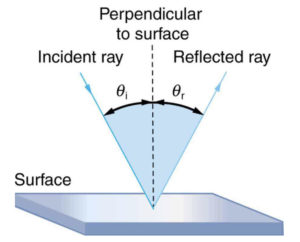

Student will understand the First and Second Laws of Reflection.įirst Law of Reflection: The incident wave, the reflected wave, and the normal at the point of incidence lie on the same plane. The angle of incidence ∠i is equal to the angle of reflection ∠r.The incident wave, the normal to the reflecting surface and the reflected wave at the point of incidence lie in the same plane.The following two laws of reflection of light are applicable to sound waves as well: Simply why angle of incidence is equal to angle of reflection In the simplest form it states that the light ray travels along a path between two points which needs the shortest time. The angle which the reflected sound waves makes with the normal is called the angle of reflection, "r". Angle between incident ray and reflecting surface normal is equal to angle between reflected ray and reflecting surface normal. The angle which the incident sound waves makes with the normal is called the angle of incidence, "i". For all practical purposes, the point of incidence and the point of reflection are the same point on the reflecting surface.Ī perpendicular drawn on the point of incidence is called the normal. The sound waves bouncing back from the reflecting surface are called reflected sound waves. The sound waves that travel towards the reflecting surface are called the incident sound waves. What are incident and reflected sound waves? The waves are called the incident and reflected sound waves. When sound travels in a given medium, it strikes the surface of another medium and bounces back in some other direction, this phenomenon is called the reflection of sound. How do we describe the reflection of sound? The law for reflection is the same as that of light, ie., the angle of incidence of a sound wave equals the angle of reflection, just as if it were produced by a 'mirror image' of the stimulus on the opposite side of the surface.

If a sound is not absorbed or transmitted when it strikes a surface, it is reflected. The speed of sound is determined by the properties of the air, and not by the frequency or amplitude of the sound. Sound propagates through air as a longitudinal wave. Common examples include the reflection of light, sound and water waves. Reflection is the change in direction of a wavefront at an interface between two different media so that the wavefront returns into the medium from which it originated. Sometimes this knowledge is irrelevant in the image making process. What that means is that when a light source strikes an object, it bounces off of the object at an equivalent angle. To verify the laws of reflections of sound. Here, he speaks in depth about the basic principles of light: Simply put, the sentiment is this: the angle of reflection is always equal to the angle of incidence.


 0 kommentar(er)
0 kommentar(er)
